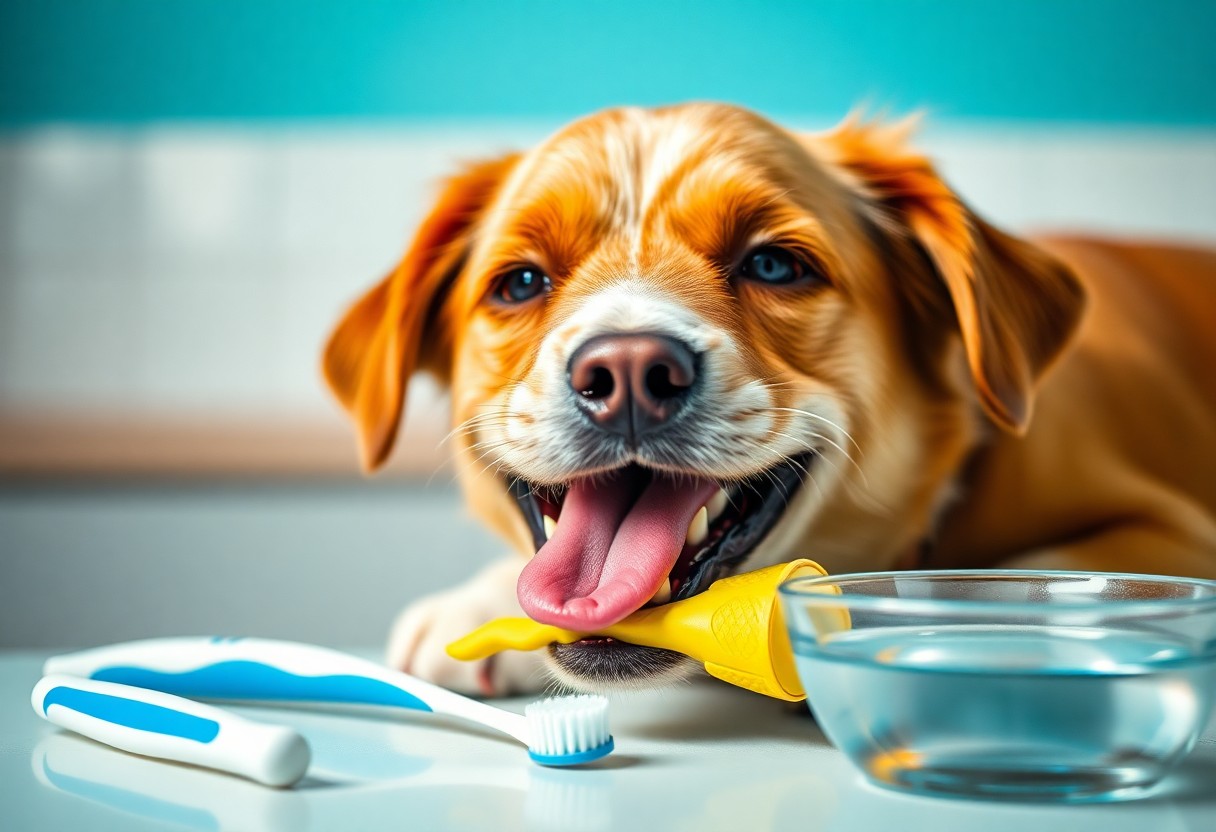Dental care plays a vital role in maintaining your dog’s overall health and wellbeing. By following simple and consistent practices, you can effectively prevent dental issues such as plaque buildup, gum disease, and bad breath in your furry friend. In this guide, you will discover practical steps to keep your dog’s teeth clean and healthy, ensuring they enjoy a happy, pain-free mouth for years to come. Taking a proactive approach will not only enhance your pet’s comfort but also contribute to their long-term vitality.
Importance of Dental Health in Dogs
The health of your dog’s teeth plays a significant role in their overall well-being. Proper dental care helps prevent the buildup of plaque and tartar, which can lead to painful issues and infections. By maintaining good oral hygiene, you not only enhance your dog’s comfort but also extend their quality of life. Paying attention to their dental health is a proactive step you can take to ensure your furry friend stays happy and healthy.
Common Dental Issues
Any dog can develop dental problems such as periodontal disease, broken teeth, or gum inflammation if their teeth are not cared for regularly. These issues often lead to pain, bad breath, and difficulty eating. By recognizing these common dental problems early, you can take action to avoid more serious complications and keep your dog’s mouth in good condition.
Impact on Overall Health
Behind your dog’s shiny coat and bright eyes, dental health affects more than just their mouth. Infections and inflammation from poor oral hygiene can spread bacteria to vital organs, including the heart and kidneys. This means that neglecting your dog’s teeth could impact their entire body and lead to severe health concerns down the line.
A strong connection exists between dental health and overall wellness in dogs. When bacteria from dental diseases enter the bloodstream, it can trigger systemic infections and even exacerbate preexisting health conditions. As a caring pet owner, you have the power to prevent these risks by implementing effective dental care routines tailored to your dog’s needs. This approach not only protects their teeth but also supports their long-term health and vitality.
1. Brush your dog’s teeth regularly with pet-safe toothpaste.
2. Provide dental chews to reduce plaque buildup.
3. Schedule professional dental cleanings as recommended by vet.
4. Offer crunchy toys to help naturally clean teeth.
5. Avoid feeding sugary or sticky human foods to dogs.
6. Monitor your dog’s mouth for signs of dental issues.

Regular Dental Check-Ups
Even if your dog appears healthy, regular dental check-ups are imperative for maintaining their oral well-being. By scheduling routine vet visits, you can catch potential issues early and prevent serious dental diseases. These check-ups provide an opportunity for your vet to assess your dog’s teeth, gums, and overall mouth health, ensuring that you stay proactive in your pet’s dental care.
Professional Cleanings
Across veterinary clinics, professional dental cleanings involve thorough plaque and tartar removal under anesthesia. These cleanings help eliminate buildup that you can’t reach with home brushing, reducing the risk of infections and tooth loss. Regular professional cleanings complement your home care efforts, keeping your dog’s mouth fresh, healthy, and pain-free.
At-Home Assessments
Beside professional exams, you can perform simple at-home assessments to monitor your dog’s dental health. By regularly checking your dog’s teeth and gums, you notice changes like redness, swelling, or bad breath early on. This proactive approach lets you address problems before they worsen and ensures your dog remains comfortable.
And when performing at-home assessments, take time to gently inspect your dog’s teeth and gums using good lighting. Look for any abnormalities such as loose teeth, bleeding, or unusual odor, and if you detect anything concerning, contact your vet promptly. These routine checks empower you to take charge of your dog’s dental health between professional visits.
Effective Brushing Techniques
After you establish a routine, brushing your dog’s teeth becomes a straightforward task that significantly contributes to your pet’s overall health. With patience and consistency, you can effectively remove plaque and prevent dental diseases. Proper technique and the right tools are key in making the process comfortable for your dog and efficient in maintaining oral hygiene.
Choosing the Right Toothbrush and Toothpaste
Toothbrush selection is important to ensure you can reach all of your dog’s teeth without causing discomfort. Opt for a toothbrush designed for pets, typically with softer bristles and a smaller head. Paired with a toothpaste formulated for dogs, which is safe to swallow and helps break down plaque, you provide a safe and effective clean that supports your dog’s dental health.
Step-by-Step Brushing Guide
The step-by-step brushing guide walks you through the process from start to finish, helping you develop a smooth routine that your dog can tolerate and even enjoy. Taking it slow, praising your dog, and adjusting your technique as needed will give you the best results in maintaining your dog’s dental hygiene.
| Step 1 | Introduce your dog to the toothbrush and toothpaste, letting them sniff and lick the paste. |
| Step 2 | Lift your dog’s lip to expose the teeth gently. |
| Step 3 | Brush in small circular motions focusing on the gum line and outer surfaces of the teeth. |
| Step 4 | Gradually increase brushing time, aiming for two minutes total. |
| Step 5 | Offer praise or a small reward to reinforce positive behavior. |
But to maintain this routine effectively, you should be attentive to your dog’s reactions and adapt your approach if they show signs of discomfort. Consistency and positive reinforcement help your dog associate brushing with a pleasant experience, improving cooperation and ensuring you complete a thorough cleaning each time.
| Tip | Description |
| Observe Behavior | Watch for signs of stress or resistance and adjust technique accordingly. |
| Set Routine | Brush at the same time daily to build familiarity and ease. |
| Positive Reinforcement | Use treats or praise to reward your dog after brushing sessions. |
| Regular Vet Checks | Consult your veterinarian to monitor dental health and receive advice. |
Dental Treats and Chews
Keep your dog’s teeth clean and healthy by incorporating dental treats and chews into their routine. These products help reduce plaque and tartar buildup while making dental care enjoyable for your dog. When deciding on treats, ensure they are specifically designed for dental health to avoid ingredients that may harm your pet’s teeth. Regular use, combined with proper brushing, supports strong gums and fresher breath, making dental care easier for both you and your dog.
Types of Approved Dental Products
Between the many dental treats available, it’s important to choose ones approved by veterinary dental associations. Here is a comparison of common types:
| Product Type | Key Benefits |
|---|---|
| Dental Chews | Mechanically remove plaque and tartar as dog chews |
| Dental Treats | Often contain enzymes that reduce bacteria and freshen breath |
| Rawhide Chews | Help scrape between teeth but should be given with caution |
| Rubber Chew Toys | Encourage chewing without risk of ingesting harmful materials |
| Edible Dental Bones | Provide nutrients and promote chewing for oral health |
- Vet-approved dental chews
- Enzyme-based dental treats
- Non-toxic rubber chew toys
- Natural rawhide alternatives
- Edible dental bones with added vitamins
Knowing the differences helps you pick the best options for your dog’s dental care.
Benefits of Chewing for Teeth
Behind your dog’s natural chewing instincts lies a powerful ally for oral health. Chewing on appropriate treats and toys promotes removal of plaque and stimulates gums, helping prevent dental diseases. This activity naturally polishes teeth, reducing stains and tartar buildup. Encouraging chewing also supports jaw strength and mental engagement, enhancing your dog’s overall wellbeing.
In fact, chewing not only cleans your dog’s teeth but also reduces bad breath and lowers the risk of periodontal infections. By choosing safe and effective chew products, you help maintain dental hygiene while providing a rewarding exercise your dog will look forward to every day.
Diet and Nutrition for Dental Health
Many dog owners overlook the impact of diet on their pet’s dental health. Providing your dog with the right nutrition not only supports their overall well-being but also plays a significant role in maintaining clean and healthy teeth. By choosing appropriate foods and snacks, you can help reduce plaque buildup and strengthen your dog’s teeth and gums, ensuring a healthier mouth and fresher breath.
Foods that Promote Healthy Teeth
For healthier teeth, you should consider incorporating foods that naturally clean your dog’s teeth as they chew. Crunchy vegetables like carrots and specially formulated dental diets can help scrape away plaque. Additionally, treats designed for dental care can stimulate saliva production, which helps neutralize harmful acids in the mouth, supporting your dog’s oral health over time.
Avoiding Harmful Snacks
Among the treats you offer, some can contribute to dental problems. Sticky, sugary, or overly soft snacks tend to cling to your dog’s teeth, promoting plaque and tartar buildup. Avoid giving your dog table scraps or sweets, as these items can increase their risk of tooth decay and gum disease, undermining your efforts to maintain a clean mouth.
Avoiding harmful snacks means staying vigilant about what your dog consumes between meals. You should opt for dental-friendly treats that do not leave residue or cause irritation. Consistently limiting access to unhealthy snacks reduces the chances of oral infections and supports your dog’s dental hygiene routine, helping maintain strong and healthy teeth for years to come.
Signs of Dental Problems
Now that you know the importance of dental care, it’s necessary to recognize signs of dental problems in your dog. Early detection can prevent discomfort and more severe health issues. Keep an eye on your pet’s behavior and oral condition to ensure their teeth stay healthy.
Symptoms to Watch For
Among the key symptoms you should watch for are bad breath, swollen or bleeding gums, difficulty eating, and excessive drooling. You might also notice your dog pawing at their mouth or reluctance to chew toys. These signs indicate that your dog’s dental health needs your attention.
When to See a Veterinarian
The best time to see a veterinarian is if you observe persistent bad breath, loose or broken teeth, or any signs of pain such as sudden changes in eating habits. Prompt professional evaluation ensures your dog receives appropriate treatment and relief.
Indeed, regular veterinary check-ups allow for thorough dental examinations and cleanings, helping to diagnose problems that might not be visible to you. Your vet can provide specialized care and guidance to maintain your dog’s dental health long-term, preventing potential complications.
Final Words
So, maintaining your dog’s dental health is easier than you might think if you follow simple, consistent steps like regular brushing, providing dental chews, and scheduling professional cleanings. By staying proactive, you help prevent painful dental issues and support your pet’s overall well-being. For more detailed guidance, check out Cleaning Your Dogs Teeth – Dog Dental Health to ensure you’re giving your furry friend the best care possible.
 wagwagtail "only love can make your dog wag her tail"
wagwagtail "only love can make your dog wag her tail"
